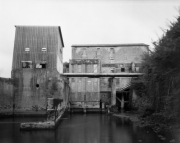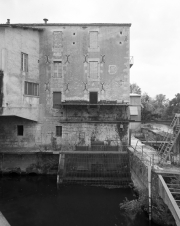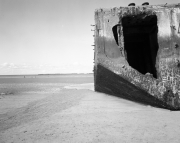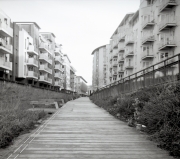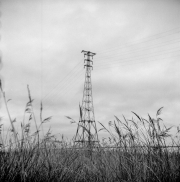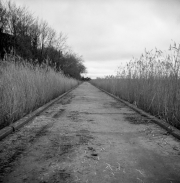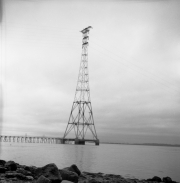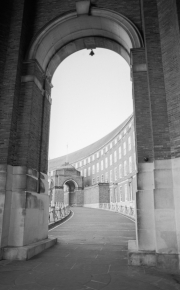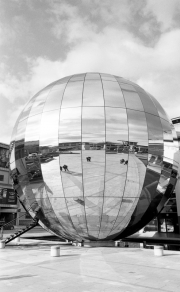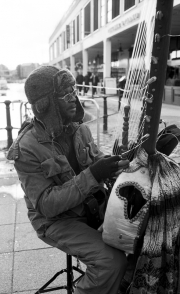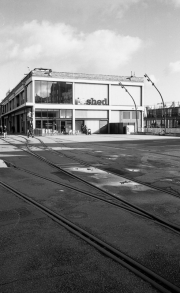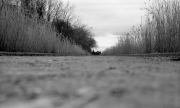Long and a bit image heavy…
I was about to post something about getting back into taking and developing my own black and white film when I realised that I haven’t actually posted anything at all about starting off with large format photography, which was where the whole film thing started – so this is going to be a long post with quite a few photos.
This dates back to late 2014 when I heard about a Kickstarter project that was launching an affordable 5×4 large format camera, the Intrepid Camera Company. That’s something I’ve thought about a few times over the last 20 years, but it’s always been way out of my league – far too expensive. But suddenly this made it affordable, so I signed up. It took them quite a while to get production sorted and I didn’t get my camera until mid-2016, and it’s been a slow process getting used to it. I started with some cheap film, which I didn’t get on with too well – it wasn’t until I put some Ilford film into it that things got better – for a start, the higher quality base made it easier to load the dark slides.
These are the first photos I took with it, during 2016 and the first half of 2017 – not too bad for a beginner, and I only butchered 1 or 2 shots. The shot of the leaf is by far the best I’ve taken with it so far.
- Two shots from my first outing with the camera at Cumberland Basin in Bristol
- Four from Goonhilly, Porthcurno and Mullion in Cornwall
- A couple from the Portway and Shirehampton in Bristol
- Two from Bristol University Botanic Garden
- Two from the Catholic Cathedral in Bristol
When we were in France last summer, I took quite a lot more with the large format. These were taken at the gite, around Fumel and at Arromanches on the Normandy coast. Some reasonable results, but work needed on exposure I think.
There’s one other set of photos I’ve taken with the large format – Not long before we went to France, I heard about Direct Positive Paper – expose like film, process like paper and it comes out with a positive image. I tried a few shots in France but didn’t get round to developing them until after I’d taken some more at Purton in Gloucestershire, home of the Purton Hulks – boats used to reinforce the bank between the Severn and the Sharpness/Gloucester canal. When I developed them, I had an “a-ha!” moment as the results were lovely, there’s a real sheen to the paper that works very well. I shall be doing more with this.
One thing I haven’t done yet with the large format is colour – I’m not that fussed about colour negative but would love to try some transparencies, but with 20 sheets of Fuji Provia costing £90 and with processing on top, I want to be very sure about what I’m doing.
Having bought some chemicals and trays for developing the Direct Positive Paper (I tried the Imago paper btw, but also have some of the Harman stuff – that’s apparently a bit harder to work with), it got me thinking about developing some 35mm film again. So I ended up buying the kit and chemicals and I’ve been quite enjoying it. When I started with the large format, I swore I wasn’t going to develop it myself – but then I saw a Paterson Orbital Processor going cheap and that means I can develop 5×4 film really quite easily. I’ve not tried it yet – it’ll be interesting to see how that goes.
So in the last month, I’ve taken 3 rolls of 35mm black & white and 3 rolls of 120 medium format – all of then have been Fuji Acros. Well, I’ve taken 4 rolls of 120 but the first one got completely trashed as I tried to load it into the spiral – my mistake was trying to use a changing bag I think, as there’s not much room to move and my hands got sweaty. I also realised it was the first roll of 120 I’d ever tried to do!
Things have got better since then, with a dark garage meaning I can load the spirals in some comfort and the rest of the films have gone in with no problems at all.
The three rolls of 120 have all been taken on my Lubitel 166 – the first set were awful but the second and third batches were much better, meaning that the problems were with the idiot in control of the camera, not the camera itself. But I think it’s fundamentally not a sharp lens so I’m on the lookout for a replacement.
The first batch – Bristol Harbourside – you’ll see a lot of this in the rest of this post as it’s very close to work and has plenty of scope for photos.
The second batch – Around the M-Shed Museum in Bristol. Much better.
The third batch – The Downs, and Aust just outside Bristol. Getting there.
The 35mm films have all been taken on different cameras.
The first film was taken with my Olympus OM1N, bought back when I also bought my first digital camera – these are from the Harbourside and around City Hall. A lovely camera, and great lenses – again, some work needed on exposure.
The second film was taken on what was my dad’s Contax G2 – this is a lovely camera, an autofocus rangefinder with brilliant lenses. It also has the advantage of auto-exposure, so these were better exposed than any of the others. These were taken around City Hall, Millennium Square and the M-Shed.
The third film was taken on my dad’s 1950s Kodak Retina I, which I had refurbished a few years ago as it was his first camera. Focus is difficult as you have to guess at the distances, and my exposure control is still in need of refinement. It’s also not massively sharp, especially when compared to the OM1N and Contax. These were taken on The Downs in Bristol and at Aust just outside Bristol.
There’s one other set of photos to mention – just before I used the OM1N, I realised that there was still a film in it. I eventually worked out that it was a roll of Kodak HIE infra-red film, and it wasn’t until after I developed it and saw what was on there that I realised it had been in the camera since April 2011! I had no idea it was there. Developing it was a bit of guesswork as no websites gave a development time for that film and the only developer I’ve got (Ilford Ilfosol 3) – I decided on something, gave it a bit extra to allow for 7 years of degredation of the latent image, and was slightly amazed that some images came out! They were taken on the Grand Union Canal just outside Northampton, at Buscot Park in Oxfordshire and in our next-door neighbour’s garden.
So I’m quite enjoying using film and look forward to doing some more of it. Developing them has been fine – I never enjoyed it in the past, but can’t really see why at the moment.
There’s quite a good online community around film and I’ve started following several people on Twitter – this has led to buying several “zines”, small self-published releases, somewhere between magazines and books. The production quality, as well as the content, has been excellent considering they’ve only been £4 or so each.





